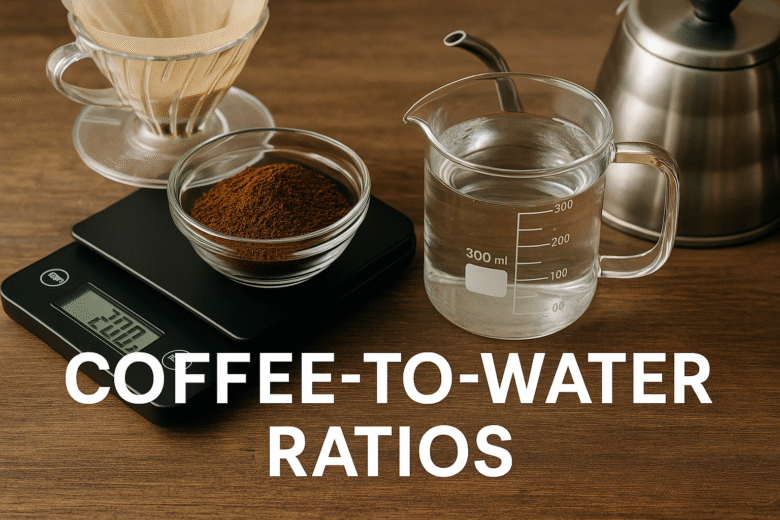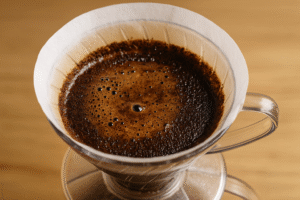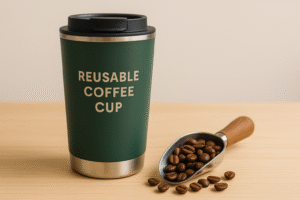One of the most important elements in brewing great coffee is the coffee-to-water ratio. This simple measurement determines the strength, flavor balance, and overall quality of your cup.
Using too much coffee can result in a bitter, overpowering brew. Too little, and your coffee tastes weak and watery. Mastering ratios ensures you can consistently recreate delicious coffee at home—no guesswork, just great results.
In this guide, you’ll learn the ideal ratios for different brewing methods, how to measure accurately, and how to adjust your coffee to taste.
Why Coffee-to-Water Ratio Matters
Coffee is made up of hundreds of compounds, and the right extraction depends on having the right balance of water and coffee.
The ratio controls:
- Strength: How intense or diluted the brew tastes
- Extraction: How well the flavors are pulled from the grounds
- Consistency: Repeating your favorite brews requires measurements
By understanding ratios, you gain full control over your coffee, whether you like it bold and rich or light and nuanced.
Standard Ratios by Brewing Method
1. Pour-Over (e.g. V60, Chemex, Kalita Wave)
Ratio: 1:15 to 1:17
Example: 20g coffee → 300ml water
Ideal for: Clean, aromatic cups with clarity and balance
2. French Press
Ratio: 1:12 to 1:15
Example: 30g coffee → 360ml water
Best for: Full-bodied, bold brews with heavy mouthfeel
3. AeroPress
Ratio: 1:10 to 1:15
Example: 17g coffee → 170–255ml water
Great for: Quick, smooth cups or espresso-style brews
4. Moka Pot
Ratio: Typically fixed based on chamber size
Example: Small Moka Pot → ~15g coffee + 150ml water
Designed for: Intense, espresso-like coffee
5. Cold Brew
Ratio (concentrate): 1:4 to 1:5
Example: 100g coffee → 500ml water
Ratio (ready-to-drink): 1:8 to 1:10
Example: 100g coffee → 800–1000ml water
Perfect for: Smooth, low-acid coffee you can dilute
6. Drip Machine (Electric Coffee Maker)
Ratio: 1:15 to 1:18
Example: 60g coffee → 1 liter of water
Balanced for: Everyday, hands-off brewing
How to Measure Coffee and Water
Using a digital scale is the most accurate way to measure both coffee and water.
Coffee:
Measured in grams. One tablespoon of ground coffee weighs around 5–7 grams, depending on grind and density.
Water:
1 milliliter = 1 gram in weight. So 250ml = 250g on the scale.
Using weight rather than volume avoids inconsistencies caused by grind size or bean density.
Adjusting to Your Taste
Start with the recommended ratio and adjust based on your preference:
- Too strong? Use a higher water ratio (e.g. 1:17)
- Too weak? Use more coffee or reduce water (e.g. 1:14)
- Too sour? Finer grind or longer brew time
- Too bitter? Coarser grind or shorter brew time
Ratios are just a foundation. Once you master them, you can customize endlessly.
How to Experiment with Ratios
Try this simple test:
- Brew three small cups using the same coffee and method
- Use ratios 1:14, 1:16, and 1:18
- Taste them side-by-side
- Take notes on body, flavor intensity, and balance
This helps you identify your sweet spot and understand how ratios change the experience.
Tips for Better Brewing Accuracy
- Use a scale and timer every time
- Grind fresh before brewing
- Keep a journal of ratios and results
- Use the same mug or container when practicing volume-based ratios
- Use filtered water with stable temperature
Consistency is key. Once you lock in your favorite ratio, you can replicate it every morning.
What About Espresso Ratios?
Espresso is measured differently, using a brew ratio of input vs. output:
- Ristretto (short): 1:1 to 1:1.5
- Standard Espresso: 1:2 (e.g. 18g in → 36g out)
- Lungo (long): 1:3 or more
Espresso requires more precision due to short brew time and high pressure. Slight changes can dramatically affect flavor.
Frequently Asked Questions (FAQs)
1. Can I just use tablespoons?
Yes, but it’s less consistent. Volume can vary depending on grind and roast. A scale ensures precision.
2. What’s the easiest ratio for beginners?
Start with 1:15—it’s balanced and works with most methods.
3. How does grind size affect ratio?
Finer grinds extract faster; coarser grinds need more time or stronger ratio. Adjust both together.
4. Why does my coffee still taste bad despite the right ratio?
Check your grind, water temp, freshness of beans, and brew time. Ratio is just one factor.
5. What if I want a stronger coffee?
Reduce water slightly (1:14), or use more coffee. Just don’t overdo it—too much can cause bitterness.
6. Can I use the same ratio for cold brew and hot coffee?
No. Cold brew needs a stronger starting ratio (1:4 to 1:5) because you’ll dilute it later.
7. Do dark and light roasts need different ratios?
Sometimes. Dark roasts often taste stronger and can handle more dilution. Light roasts may need tighter ratios for flavor clarity.
Final Thoughts – Let Ratio Be Your Guide
The coffee-to-water ratio is one of the easiest and most powerful tools to improve your brewing. Once you understand it, you’ll never guess your measurements again.
By dialing in the right ratio for your preferred method, you get consistent, delicious results every time—whether you’re brewing a pour-over at sunrise or sipping cold brew on a summer afternoon.
Remember, your perfect cup isn’t found—it’s calculated.
Agora, segue a imagem ultra realista no formato exato de 600×400 pixels refer

Marcio Luzardo is a coffee enthusiast and the voice behind Tudo Viraliza. With a passion for turning curiosity into practical knowledge, he shares easy-to-follow tips, guides, and insights to help readers enjoy better coffee every day. When he’s not writing, Marcio is exploring new brewing methods or diving into the rich stories that connect coffee to culture, lifestyle, and wellness.



